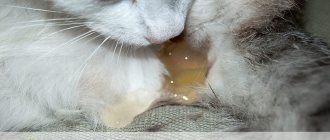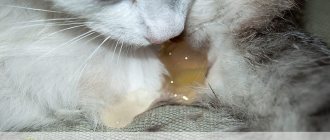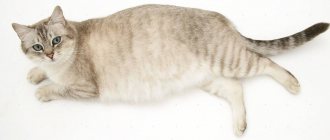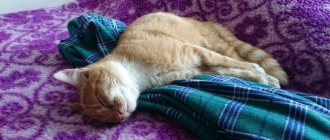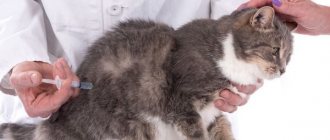17744Administration
Often, discharge from a cat on the outer labia is not considered normal and signals a problem with the animal’s health. Of course, you shouldn’t immediately panic and imagine a serious illness, because in some cases, discharge from the loop does not pose any danger.
But it won’t hurt to show your pet to a good veterinarian, since self-diagnosis is ineffective and is fraught with complications and consequences. Discharges can be very diverse :
- purulent;
- blood;
- watery;
- transparent;
- cloudy;
- white;
- gray;
- brown.
What is considered a physiological norm?
It is completely natural for a cat to have discharge during heat or estrus. The color of the discharge during this period is transparent, and the consistency is uniform without an unpleasant odor. The heat does not stop for several days, and the cat arches her back, exposes her hindquarters, and shows excessive playfulness and affection.
© shutterstock
Pregnancy and childbirth
Discharge during pregnancy may appear in a cat up to the third week. This is due to the fact that a mucus plug forms in the cervix, the excess of which flows out . This is usually clear or stringy mucus that is difficult to notice because it comes out along with urine. Until the 6th week, yellowish discharge is very rarely observed in small quantities - excess amniotic fluid.
And only a day or two before birth does the mucous plug come off (at 9 weeks). This is a small clot of yellow or greenish tint.
During contractions and pushing in a cat, the presence of brown and bloody discharge from the uterus is normal. For some time after childbirth, liquid greenish discharge appears, gradually becoming lighter, and then completely disappearing.
Scarlet blood at any stage of a cat’s pregnancy is always a sign of pathology and can be a signal of uterine rupture. The reason for the release of brown clots is placental abruption or fetal death . Green ones with an unpleasant odor indicate a bacterial infection, most likely due to the death of the kitten and the beginning of the decomposition process.
Pathologies during pregnancy and childbirth
Bloody black/green discharge during childbirth without any signs of labor is a life-threatening condition for the female.
Possible reasons:
- primary uterine laxity in combination with the death of at least one embryo and separation of the placenta
- death of embryos in the middle or late stages of pregnancy and their blood mummification
Postpartum discharge from the loop (lochia) is normal, but monitoring it is extremely important. Excretion continues from 7 to 30 days, gradually changing color to lighter and decreasing in volume.
In the absence of complications, at first the lochia have a greenish color (the first day), then they become light pink. If they are odorless and not accompanied by high fever, indigestion and other painful symptoms, then there is no reason to worry.
Bloody discharge, or a change in the color of lochia (dirty green, brown) with an unpleasant odor, accompanied by tension in the abdominal wall, symptoms of intoxication, and high temperature should be a reason for an urgent call to a veterinary gynecologist.
Foul-smelling red purulent clots after childbirth are signs of postpartum metritis, which developed as a result of bacteria entering the uterus during childbirth, auxiliary manipulations, retained fetal membranes, and miscarriage.
The female shows signs of intoxication, she is depressed and refuses to eat. Body temperature is high, as evidenced by a hot, dry nose and heavy breathing.
As a result of cessation of lactation, babies cry from hunger and cold. Possible maternal death.
Unhealthy uterine discharge
Inflammatory diseases of the uterus lead to the accumulation of pathological substances in its cavity - waste products of bacteria, ichor, particles of epithelium, etc. Blood or pus from the vaginal opening may be a symptom of urogenital tract cancer. A cat suffers from discharge due to the following dangerous diseases:
- vaginitis;
- pyometra;
- hematometers;
- hydrometers;
- endometritis.
Vaginitis
This is an inflammatory process in the vagina, which can be acute or chronic. Ulcers form on the surface of the mucous membrane, and the cat is bothered by discharge:
- cloudy or transparent;
- viscous yellow-white;
- mucous membranes are purulent.
Mild forms of the disease are treated with douching; in severe cases, systemic antibiotics are indicated.
© shutterstock
Pyometra
Life-threatening inflammation of the uterus, requiring urgent medical attention and surgical intervention. If a cat frequently licks itself, and brown wet spots remain everywhere on the bedding and carpets, then such symptoms should alert the owner. There are also other warning signs:
- tight or bloated belly;
- increased body temperature;
- lack of appetite, but strong thirst;
- frequent urination;
- decreased physical activity of the pet, lethargy.
In some cases, the cat's purulent discharge increases in quantity so quickly that the symptoms of the disease simply do not have time to appear. The walls of the uterus cannot withstand the load and rupture, and the contents spill into the abdominal cavity . Naturally, it is no longer possible to save the pet’s life.
Hematometer
The condition is characterized by the accumulation of blood in the uterine cavity, disrupting the functioning of the organ. Often blood cannot escape due to blockage or narrowing of the cervical canal, so the discharge from the cat's uterus is very scanty. The reason may be:
- congenital anomalies;
- muscle spasm of the cervical canal;
- surgical procedures performed incorrectly;
- miscarriage or abortion;
- pathological births (especially if they happen more than 1-2 times a year);
- uterine fibroids.
Blood is a rich nutrient medium for the proliferation of harmful microorganisms, which is why sooner or later inflammation of the uterus begins.
The cat has a fever and cramping pain appears. When helping an animal, clots must be scraped out of the uterine cavity and antibacterial therapy is prescribed. If hematometra is not diagnosed in time, purulent contents form in the uterus and the disease is complicated by pyometra. Fortunately, this disease is quite rare.
Endometritis
In a cat, discharge from the uterus may be a symptom of inflammation of the walls or mucous membranes of the organ. Acute endometritis occurs more often after childbirth due to delayed release of the placenta, infection of the vagina and cervix.
Mucopurulent discharge appears in cats from the genital slit 2–6 days after the birth of kittens.
Urination becomes more frequent, milk production decreases, and the temperature rises. The animal arches its back and meows pitifully due to pain in the uterus. In the absence of therapy, the pathology becomes chronic. The infection spreads to the muscular and outer layers of the uterus and penetrates the blood. As a result, the pet dies due to sepsis. Blockage of the cervical canal threatens the development of pyometra.
© shutterstock
Hydrometer
Fluid accumulates in the uterine cavity - gland secretion, mucus, transudate in quantities of up to 10 liters. If the excretory channel is open or partially blocked, then the cat experiences white or transparent discharge. Usually they are scanty, smearable or drop-shaped. The disease often develops against the background of chronic endometritis , as a result of which the uterine walls become thinner and stretched, adhesions and scars form. Without timely treatment, the cat dies.
Is your pet sick? Feels bad?
Leave a request Or call us at:
8
Features of the treatment of Urolithiasis
If you suspect that your cat has urolithiasis, we recommend that you immediately contact your veterinarian. Only a competent specialist will be able to accurately determine the stage of the disease, identify the number, composition and size of stones. Set the level of complexity of the disease.
Important! If an animal has blocked canals, severe poisoning of the body, or obstruction of the urinary tract, then every minute will count!
The main factor in the treatment of urolithiasis for the animal owner should be the recommendations of a veterinarian. The fundamental ones are:
- pet's diet;
- quality and quantity of food intake;
- availability of clean drinking water in free access;
- If oxalate stones (with an insoluble structure) are detected, exclude foods rich in calcium, liver, sour vegetables from the diet, limit meat, fish, eggs.
Drug therapy for urolithiasis
Urolithiasis in neutered cats most often requires drug treatment. Only a veterinarian can prescribe medications necessary for an animal. Based on the test results of the animal, its condition. It is unacceptable to self-medicate urolithiasis in cats. May be assigned:
- Antibiotics. Used only in the presence of an infectious disease. Antibiotics from the group of cephalosporins are most often used.
- Uroseptics are used - 5-NOK, Furagin. Prescribed for the treatment of the genitourinary system.
- Regidron is used when the animal is severely dehydrated.
- Cantaren can be used for a diuretic effect.
- For pain, give No-shpa, Baralgin.
If the animal cannot relieve itself on its own, it is catheterized. Using a special tube through which urine and stones are removed. You may need to rinse your bladder to remove the stones. In the case of large stones, calcium deposits, or blockage of urine ducts, surgical intervention may be prescribed.
Bloody discharge in cats
Blood discharge in a cat is almost always not a good sign, indicating serious illness. It is not possible for the owner to figure out on his own what the reason for this is.
An examination in a hospital setting, tests, ultrasound, and possibly cytological and histological studies will be required.
Our network of clinics has all the necessary equipment, so the examination will take place quickly, and soon the results of the research will be in your hands. Based on them, the veterinarian will draw a conclusion about what is wrong with your pet and begin immediate treatment for the cat.
Bloody discharge in a cat can indicate a serious pathology, sometimes when it occurs it can take hours, so don’t delay, contact your veterinarian for help as soon as possible. Only an experienced doctor who has the necessary equipment to conduct an examination will be able to accurately determine the cause and help save your cat’s life!
Prices for appointments in our clinics
| Name of veterinary services | Unit | Price, rub |
| ⭐ Initial appointment | 1 animal | 400 |
| ⭐ Repeated appointment | 1 animal | 250 |
| Initial appointment with a specialist | 1 animal | 1100 |
| Consultation without an animal | — | 550 |
| Consultation with a doctor based on test results | 1 PC. | 400 |
| Weighing animals | 1 animal | For free |
| Additional fixation for aggressive animal behavior | 1 animal | 700 |
APPOINTMENT AT THE CLINIC
HOME CALL
All our Veterinary Clinics:
For any suggestions regarding the site: [email protected]
|


